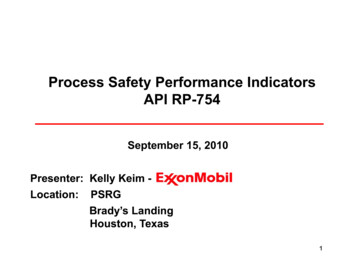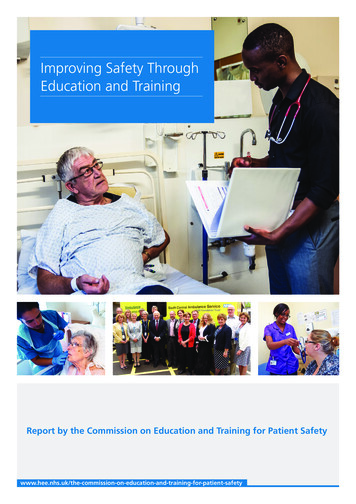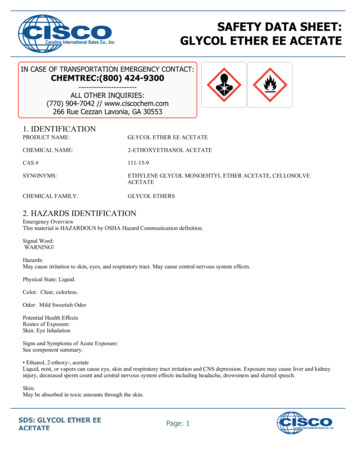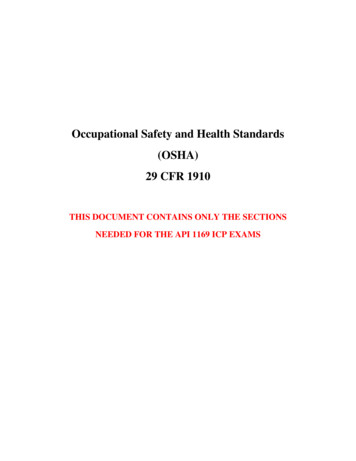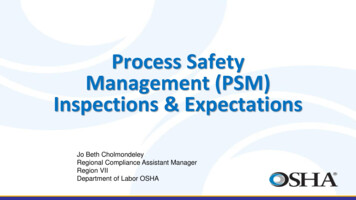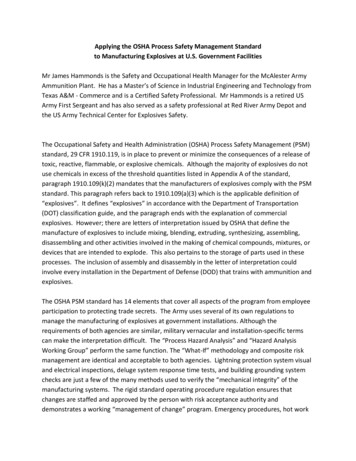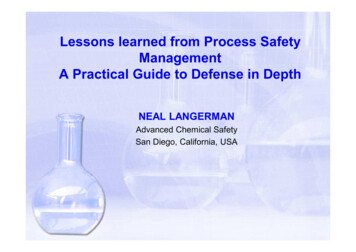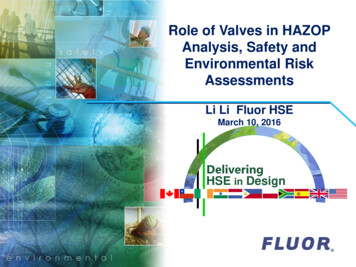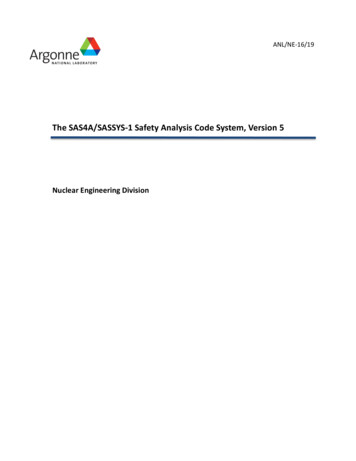
Transcription
ANL/NE-16/19The SAS4A/SASSYS-1 Safety Analysis Code System, Version 5Nuclear Engineering Division
About Argonne National LaboratoryArgonne is a U.S. Department of Energy laboratory managed by UChicago Argonne, LLCunder contract DE-AC02-06CH11357. The Laboratory’s main facility is outside Chicago, at9700 South Cass Avenue, Argonne, Illinois 60439. For information about Argonne and itspioneering science and technology programs, see www.anl.gov.Document AvailabilityOnline Access: U.S. Department of Energy (DOE) reports produced after 1991 and agrowing number of pre-1991 documents are available free via DOE’s SciTech Connect(http://www.osti.gov/scitech/)Reports not in digital format may be purchased by the public from theNational Technical Information Service (NTIS):U.S. Department of CommerceNational Technical Information Service5301 Shawnee RdAlexandria, VA 22312www.ntis.govPhone: (800) 553-NTIS (6847) or (703) 605-6000Fax: (703) 605-6900Email: orders@ntis.govReports not in digital format are available to DOE and DOE contractors from theOffice of Scientific and Technical Information (OSTI):U.S. Department of EnergyOffice of Scientific and Technical InformationP.O. Box 62Oak Ridge, TN 37831-0062www.osti.govPhone: (865) 576-8401Fax: (865) 576-5728Email: reports@osti.govDisclaimerThis report was prepared as an account of work sponsored by an agency of the United States Government. Neither theUnited States Government nor any agency thereof, nor UChicago Argonne, LLC, nor any of their employees or officers,makes any warranty, express or implied, or assumes any legal liability or responsibility for the accuracy, completeness, orusefulness of any information, apparatus, product, or process disclosed, or represents that its use would not infringeprivately owned rights. Reference herein to any specific commercial product, process, or service by trade name,trademark, manufacturer, or otherwise, does not necessarily constitute or imply its endorsement, recommendation, orfavoring by the United States Government or any agency thereof. The views and opinions of document authors expressedherein do not necessarily state or reflect those of the United States Government or any agency thereof, Argonne NationalLaboratory, or UChicago Argonne, LLC.
ANL/NE-16/19The SAS4A/SASSYS-1 Safety Analysis Code System, Version 5Chapter 1:IntroductionT. H. Fanning and J. E. CahalanNuclear Engineering DivisionArgonne National LaboratoryMarch 31, 2017
The SAS4A/SASSYS-1 Safety Analysis Code System, Version 51-iiANL/NE-16/19
IntroductionTABLE OF CONTENTSTable of Contents . 1-iiiIntroduction . 1-11.1 SAS4A/SASSYS-1 Background . 1-11.2 SAS4A/SASSYS-1 Version 5 . 1-31.3 Documentation Overview. 1-3References . 1-7ANL/NE-16/191-iii
INTRODUCTIONThe SAS4A/SASSYS-1 computer code is developed by Argonne National Laboratoryfor thermal, hydraulic, and neutronic analysis of power and flow transients in liquidmetal-cooled nuclear reactors (LMRs). SAS4A was developed to analyze severe coredisruption accidents with coolant boiling and fuel melting and relocation, initiated by avery low probability coincidence of an accident precursor and failure of one or moresafety systems. SASSYS-1, originally developed to address loss-of-decay-heat-removalaccidents, has evolved into a tool for margin assessment in design basis accident (DBA)analysis and for consequence assessment in beyond-design-basis accident (BDBA)analysis.SAS4A contains detailed, mechanistic models of transient thermal, hydraulic,neutronic, and mechanical phenomena to describe the response of the reactor core, itscoolant, fuel elements, and structural members to accident conditions. The core channelmodels in SAS4A provide the capability to analyze the initial phase of core disruptiveaccidents, through coolant heat-up and boiling, fuel element failure, and fuel meltingand relocation. Originally developed to analyze oxide fuel clad with stainless steel, themodels in SAS4A have been extended and specialized to metallic fuel with advancedalloy cladding.SASSYS-1 provides the capability to perform a detailed thermal/hydraulicsimulation of the primary and secondary sodium coolant circuits and the balance-ofplant steam/water circuit. These sodium and steam circuit models include componentmodels for heat exchangers, pumps, valves, turbines, and condensers, andthermal/hydraulic models of pipes and plena. SASSYS-1 also contains a plant protectionand control system modeling capability, which provides digital representations ofreactor, pump, and valve controllers and their response to input signal changes.1.1SAS4A/SASSYS-1 BackgroundIn the late 1960s, the then U.S. Atomic Energy Commission gave development of aliquid-metal-cooled fast reactor (LMR) a high priority, and the development of the FastFlux Test Facility (FFTF) became a cornerstone of that program. To provide adequatesupport for the FFTF and for the expected LMRs to follow, a major base technologyprogram was established which provided a continuous stream of experimentalinformation and design correlations. This experimental data would either confirmdesign choices or prove the need for design modifications. At the time, the “tremendousamount of data and experience pertaining to thermal design” of LMRs was recognizedas providing the technical foundation for the future commercial development ofLMRs.[1-1]Along with the generation of experimental data came the development of safetyanalysis methods that used that data in correlations for mechanistic, probabilistic, orphenomenological models. These models were developed for a variety of needs rangingfrom individual components, such as heat exchangers, pumps, or containment barriers,to whole core or even whole-plant dynamics. A major portion of the overall technicalANL/NE-16/191-1
The SAS4A/SASSYS-1 Safety Analysis Code System, Version 5effort since that time has been allocated to safety considerations, and theSAS4A/SASSYS-1 safety analysis code is the result of that dedication.Perhaps the strongest factor that influenced early fast reactor safety analysis wasthe concern over the possibility of core compaction followed by an energetic coredisassembly — the so-called Bethe-Tait accident.[1-2] In the late 1960s, the HanfordEngineering Development Laboratory (HEDL) began developing the MELTcode[1-3,1-4] to evaluate the initiating phase of hypothetical core disruption accidents(HCDA) as part of the FFTF project. The MELT series of codes has the capability tomodel the transient behavior of several representative fuel pins (channels) within areactor core to allow for incoherency in the accident sequence. By 1978 MELT hadevolved into the MELT-IIIB code.[ 1-4]Around the same time that development on MELT began, Argonne NationalLaboratory began developing the SAS series of codes.[1-5–1-9] Like MELT, SAS has thecapability to model the transient behavior of several representative channels toevaluate the initiating phase of HCDAs. SAS1A originated from a sodium boiling modeland includes single- and two-phase coolant flow dynamics, fuel and cladding thermalexpansion and deformation, molten fuel dynamics, and a point kinetics model withreactivity feedback. By 1974, SAS evolved to the SAS2A computer code[1-6] whichincluded a detailed multiple slug and bubble coolant boiling model which greatlyenhanced the ability to simulate the initiating phases of loss-of-flow (LOF) and transientoverpower (TOP) accidents up to the point of cladding failure and fuel and claddingmelting.The SAS3A code [1-7] added mechanistic models of fuel and cladding melting andrelocation. This version of the code was used extensively for analysis of accidents in thelicensing of FFTF. In anticipation of LOF and TOP analysis requirements for licensing ofthe Clinch River Breeder Reactor Plant (CRBRP), new fuel element deformation,disruption, and material relocation models were written for the SAS4A version of thecode,[1-8] which saw extensive validation against TREAT M-Series test data. Inaddition, a variant of SAS4A, named SASSYS-1, was developed with the capability tomodel ex-reactor coolant systems to permit the analysis of accident sequencesinvolving or initiated by loss of heat removal or other coolant system events. Thisallows the simulation of whole-plant dynamics feedback for both shutdown and offnormal conditions, which have been validated against EBR-II Shutdown Heat RemovalTest (SHRT) data and data from the FFTF LOF tests.Although SAS4A and SASSYS-1 are generally portrayed as two computer codes, theyhave always shared a common code architecture, the same data management strategy,and the same core channel representation. Subsequently, the two code branches weremerged into a single code referred to as SAS4A/SASSYS-1. Version 2.1 of theSAS4A/SASSYS-1 code [1-10,1-11] was distributed to Germany, France, and Japan in thelate 1980s, and it serves as a common tool for international oxide fuel modeldevelopments.Beyond the release of SAS4A/SASSYS-1 v 2.1, revisions to SAS4A/SASSYS-1continued throughout the Integral Fast Reactor (IFR) program between 1984 and1-2ANL/NE-16/19
Introduction1994,[1-12] culminating with the completion of SAS4A/SASSYS-1 v 3.0 in 1994.[1-13]During this time, the modeling emphasis shifted towards metallic fuel and accidentprevention by means of inherent safety mechanisms. This resulted in 1) addition of newmodels and modification of existing models to treat metallic fuel, its properties,behavior, and accident phenomena, and 2) addition and validation of new capabilitiesfor calculating whole-plant design basis transients, with emphasis on the EBR-II reactorand plant [1-14], the IFR prototype. The whole-plant dynamics capability of the SASSYS1 component plays a vital role in predicting passive safety feedback. Without it,meaningful boundary conditions for the core channel models are not available, andaccident progression is not reliably predicted.By the mid 1990s, SAS4A/SASSYS-1 v 3.1 had been completed as a significantmaintenance update, but it was not released until 2012.[1-15]1.2SAS4A/SASSYS-1 Version 5In the time since the development of Version 3, several modeling additions andenhancements have been made to meet U.S. Department of Energy programmaticneeds. Significant among these are Detailed sub-channel models for whole-core analyses to resolve intra-assemblytemperature and flow distributions [1-9]3D visualization capabilities for sub-channel results.Extended decay-heat models to support long-term transients and complex,actinide-bearing fuels.Support for coupling with external CFD simulations to resolve flow distributionand thermal stratification effects.Treatment of axial expansion feedback from assembly duct wallsSupport for spatial kinetics (requires DIF3D-K)Extension of the control-system model to include sinusoidal functions that canbe used to represent seismic oscillation effects.Addition for heavy liquid-metal coolants (lead and lead-bismuth eutectic)Support for user-defined coolant propertiesDetailed steam-generator model updatesSeveral bug fixes and other enhancementsIn addition to the above, a major restructuring of the code has been completed toadapt all source files to free-form source format and new model developments arebeing implemented using modern object-oriented practices. Documentation Overview1.3Documentation OverviewThe rest of this manual contains details of the modeling capabilities ofSAS4A/SASSYS-1. The chapter organization shown in Table 1.3-1 reflects the majormodel delineations. Each chapter provides in-depth descriptions of the models,including model formulations, solution techniques, and input descriptions. It is criticalthat users understand the relationships between their model input and the modelANL/NE-16/191-3
The SAS4A/SASSYS-1 Safety Analysis Code System, Version 5formulations given in this manual. Failure to understand these relationships can resultin broken models and misleading results.SAS4A/SASSYS-1 provides a detailed, multiple-channel thermal/hydraulictreatment of the reactor core. Each channel represents a fuel pin, its cladding, theassociated coolant, and a fraction of the subassembly duct wall. Other positioninghardware, such as wire wraps or grid spacers, is usually lumped into the structure fieldwith the duct wall. Within a channel, the flow is assumed to be one-dimensional in theaxial direction, and the temperature field in the fuel, cladding, coolant, and structure isassumed to be two-dimensional in the radial and axial directions. Usually, a channelrepresents an average fuel element in a subassembly or a group of subassemblies. Achannel may also represent pins in blanket or control subassemblies. Alternately, asingle channel may also be used to represent the hottest pin in an assembly, or anyother subset of a subassembly. The axial extent of a channel covers the entire length of asubassembly, including the core, the axial blankets, the fission gas plenum and thespaces above and below the pin/cladding geometry. Different channels may be used toaccount for radial and azimuthal design geometry, power, coolant flow, and burnupvariations within the reactor core.Table 1.3-1: Organization of the SAS4A/SASSYS-1 ManualChapter1-4Subject1Introduct
models for heat exchangers, pumps, valves, turbines, and condensers, and thermal/hydraulic models of pipes and plena. SASSYS-1 also contains a plant protection and control system modeling capability, which provides digital representations of reactor, pump, and valve controllers and their response to input signal changes. 1.1 SAS4A/SASSYS-1 Background In the late 1960s, the then U.S. Atomic .


